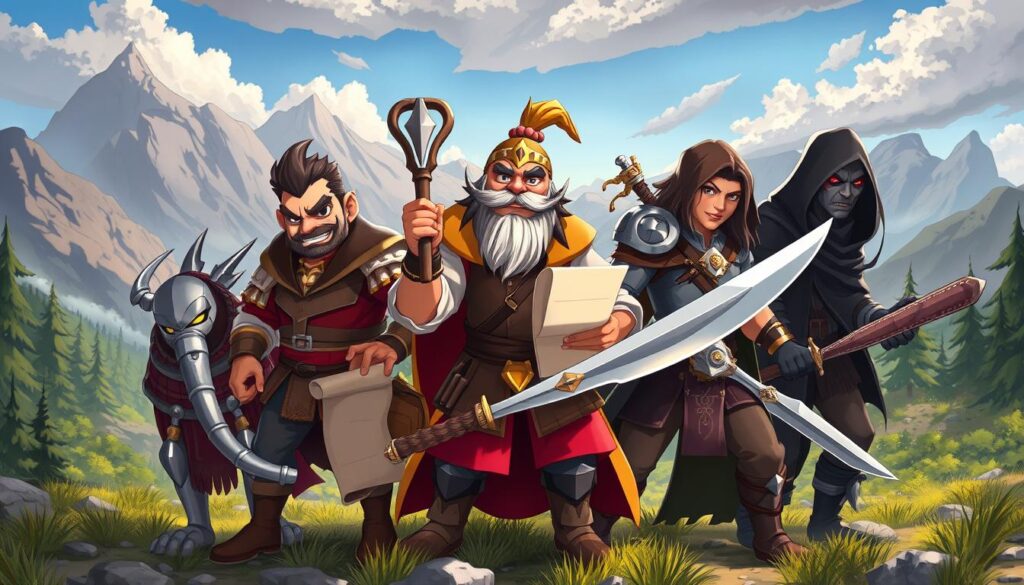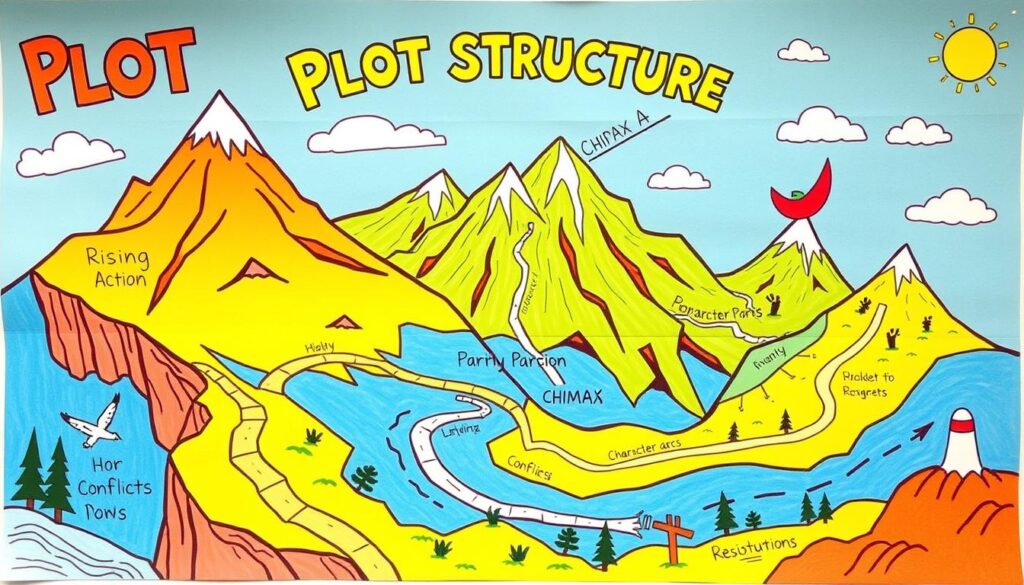Creating exciting adventure stories has been a favorite for centuries. It’s an art that draws in readers and keeps them hooked. Whether you’re a pro or just starting, knowing the key parts of adventure fiction is crucial. This guide will share the secrets to making your stories thrilling and engaging.

Key Takeaways
- Discover the fundamental building blocks of captivating adventure stories
- Explore techniques for crafting immersive settings and characters that come to life
- Learn how to create high-stakes conflicts and suspenseful plot twists
- Develop a deep understanding of pacing, tension, and action sequences
- Gain insights into developing memorable heroes and villains
Understanding the Essential Elements of Adventure Fiction
To create an exciting adventure story, you need to know the key elements. These elements grab readers and take them to new, thrilling places. Each part, from the settings to the characters, is crucial for a great story. Let’s look at the main elements that make adventure fiction exciting and how to use them well.
Setting and World-Building in Adventure Stories
The setting of your story is more than just a background. It’s alive and affects the characters and the story. Spend time on world-building to make detailed environments. These should be beautiful and important to the story.
Whether it’s a lush jungle, a harsh wasteland, or a magical realm, make it come alive. This will draw readers in and make them want to explore and discover more.
Character Development for Action-Packed Tales
Great characters are the heart of any adventure story. Your heroes should be complex, with flaws and personal reasons for their actions. Character development is key to making readers care about them.
Make your characters unique, with their own stories and reasons. Let them grow as they face challenges and conflicts.
The Role of Conflict and Stakes
At the heart of any adventure is conflict. This is what tests the heroes and makes the story exciting. Create conflicts that are thrilling and meaningful.
Make sure the stakes are high, with real consequences for failure. As the story goes on, the conflicts should get tougher. This keeps readers on the edge of their seats, wanting to know how the heroes will overcome their challenges.
| Element | Importance in Adventure Fiction | Key Considerations |
|---|---|---|
| Setting and World-Building | Provides the vibrant, immersive backdrop that captivates readers and fuels a sense of discovery. | Detailed, visually rich environments Unique cultural elements and traditions Incorporation of fantastical or futuristic elements |
| Character Development | Brings the adventure to life through dynamic, emotionally compelling protagonists. | Multifaceted characters with flaws and personal stakes Character arcs that evolve alongside the narrative Distinctive personalities and motivations |
| Conflict and Stakes | Generates high-stakes tension and challenges that drive the plot forward and test the characters’ limits. | Substantial, meaningful conflicts with genuine consequences Escalating challenges that push the characters to their breaking point Exploration of ethical dilemmas and moral quandaries |
Mastering world-building, character development, and conflict in fiction will help you create an adventure story that grabs readers. They’ll be eager to dive into your world and follow your characters’ journeys.
How to Write Adventure Storys: From Concept to Completion
Creating an exciting adventure story needs a clear writing process. Start by brainstorming great ideas for your plot. Think about amazing settings, lively characters, and exciting conflicts that will grab your readers’ attention.
After you have a strong story outline, start working on your adventure plot development. Make sure your story flows well, with events that keep your readers on the edge of their seats. Add challenges, surprises, and big moments that push your characters and drive the story to its end.
- Brainstorm compelling adventure story ideas
- Develop a detailed outline to guide your writing
- Craft an adventure plot with engaging twists and turns
- Refine your narrative structure for maximum impact
- Revise and polish your adventure story until it shines
The writing process for adventure stories is a journey of trial and error. Be ready to try new things, make changes, and improve your work. This way, you’ll create a story that will make your readers want more.
“The true alchemists do not change lead into gold; they change the world into words.” – William H. Gass
Crafting Compelling Action Sequences That Keep Readers Hooked
Writing exciting action scenes is key for any adventure writer. You can pull readers into the action by mastering pacing, tension, and fight scenes. Let’s dive into the techniques that will make your action scenes unforgettable.
Pacing and Tension Building Techniques
The pace of your action scenes is crucial for keeping readers hooked. Mix fast sentences with longer ones to build urgency and intensity. Add calm moments to let readers breathe and build anticipation for more action. This careful pacing creates tension that keeps readers on the edge of their seats.
Balancing Action with Character Moments
Thrilling action is important, but so is character development. Add moments of reflection, dialogue, and emotional depth to connect readers with your characters. This balance makes your story engaging and emotionally resonant.
Writing Dynamic Fight Scenes
Creating vivid fight scenes is an art. Focus on sensory details like sounds, touch, and visuals. Use different fighting styles and unexpected moves to keep readers excited. Your goal is to make readers feel like they’re part of the action.
Mastering pacing, tension, and fight scenes will make your action sequences thrilling. Find the right balance between action and character moments. With practice, you’ll craft stories that leave readers eager for more.
Creating Memorable Heroes and Villains for Your Adventure
Making heroes and villains that grab your readers’ attention is key in adventure stories. Knowing about character archetypes and the hero’s journey helps you craft heroes that people will love. It’s also vital to create villains with complex motives and actions. These can challenge the hero and keep the story exciting.
Using the hero’s journey is a great way to make heroes memorable. This timeless story pattern shows the hero’s growth from start to finish. As they face different challenges, their story becomes more engaging.
Creating a strong opponent for the hero is also crucial. A well-made villain should have their own goals, fears, and history. By exploring character archetypes like the tyrant or manipulator, you can make your villain more interesting.
“The greatest trick the devil ever pulled was convincing the world he didn’t exist.”
Remember, the antagonist development is as important as the hero’s story. A tough foe can make the hero grow and face new challenges. This makes your story unforgettable.

The heart of adventure fiction is its characters. By understanding character archetypes, the hero’s journey, and how to develop villains, you can write stories that stick with readers.
World-Building Techniques for Adventure Settings
Crafting immersive fictional worlds is key to writing exciting adventure stories. By using smart world-building techniques, you can take readers into amazing realms. These realms make your stories more thrilling and real.
Research and Authenticity in Setting Description
Doing thorough research is the base for believable and vivid adventure settings. Look into history, geography, and culture to make your descriptions real. Include small details like local customs, landscapes, and building styles to make your story’s world feel real.
Incorporating Cultural Elements
Adventure stories are made better by mixing different cultures and traditions. Add real cultural touches, like art, stories, or food, to enrich your worlds. This makes your settings more believable and lets you show the richness of human experiences.
Environmental Challenges and Obstacles
Use the natural world to make your stories more tense and exciting. Add tough environmental hurdles, like hard terrain, bad weather, or wild animals, for your characters to face. These challenges test your heroes and make the story more thrilling for readers.
By using these world-building tips, you can make settings that pull readers into amazing worlds. From careful research to adding cultural and environmental elements, your hard work will make your stories come alive. This will keep readers hooked and eager to find out what happens next.
Plot Development and Story Structure in Adventure Writing
Creating an exciting adventure story needs a well-planned plot. It should grab readers from start to finish. Knowing how to use plot structure and narrative arcs is key. With the right story pacing, your tale will keep readers hooked.
The hero’s journey is a big part of adventure fiction. It shows the hero’s journey, with many challenges. This structure makes your story relatable and engaging.
- Start with a strong inciting incident to kick off the adventure.
- Add rising action to build suspense and excitement towards the climax.
- Finish with falling action and a resolution that wraps up the story nicely.
Good story pacing keeps readers interested. Mix fast-paced action with character growth and exploration. Cliffhangers and surprises keep readers eager to find out what happens next.

Creating great adventure stories is all about a well-structured plot. By understanding plot structure, narrative arcs, and story pacing, you’ll captivate your audience. They’ll be looking forward to your next adventure.
Building Suspense and Managing Plot Twists
Creating exciting stories often depends on how well you build suspense and add unexpected twists. As a writer, you have many tools to keep your readers eager for more.
Foreshadowing and Red Herrings
Foreshadowing is a key tool for building suspense. By dropping hints about what’s to come, you spark curiosity and anticipation. But, don’t give away too much too soon. Using red herrings can also mislead your audience, making the twists even more surprising.
Cliffhangers and Chapter Endings
Cliffhangers are a classic way to keep readers hooked. Ending chapters with a cliffhanger makes them want to keep reading. Learning to end chapters with a cliffhanger is a great way to keep your readers coming back.
Surprise Elements That Work
- Unexpected character reveals or betrayals
- Sudden plot developments that challenge the protagonist’s assumptions
- Shocking twists that upend the established narrative
- Subverting genre tropes or reader expectations
For surprise elements to work, they must feel natural and true to your story. Mixing the unexpected with logical character and plot progression makes your suspense techniques unforgettable.
“The greatest trick the devil ever pulled was convincing the world he didn’t exist.” – The Usual Suspects
This quote shows the power of surprise and misdirection in stories. It’s a principle for creating plot twists that leave readers amazed.
Conclusion
Adventure writing is a thrilling craft that mixes storytelling with a writer’s toolkit. It involves creating captivating settings and memorable characters. It also means crafting exciting action sequences.
Improving your adventure writing skills can be challenging. But the real reward is in the journey of getting better. Keep practicing and trying new things. Dive into the worlds of your favorite stories.
Remember, the tips in this guide are just the start. Use them to build your own unique storytelling style. Be bold, try new things, and follow your passion. This way, you’ll create stories that truly stand out.
FAQ
What are the essential elements of an adventure story?
Adventure stories need an exciting plot, dynamic characters, and a vivid setting. A strong conflict and high stakes are key to keep readers interested.
How can I create a compelling adventure story setting?
To create a great setting, do thorough research and add real cultural elements. Design obstacles that challenge your characters. Use sensory details to make the world come alive.
What are some tips for developing memorable protagonists and antagonists?
Make your characters well-rounded and complex. Explore archetypes and the hero’s journey. Create villains that challenge your hero.
How can I write thrilling action sequences that keep readers engaged?
Use effective pacing and tension to make action scenes exciting. Mix action with character development for a full experience.
What are some strategies for managing plot twists and building suspense?
Use foreshadowing, red herrings, and cliffhangers to surprise readers. Plan your plot well to deliver twists that add to the adventure.




